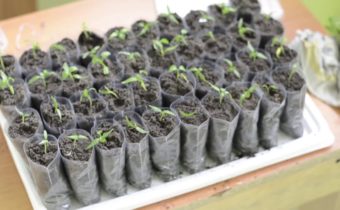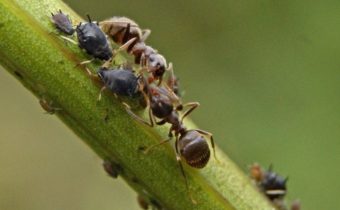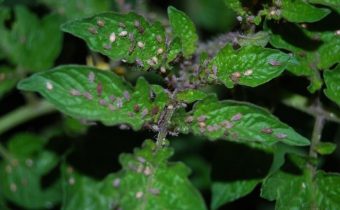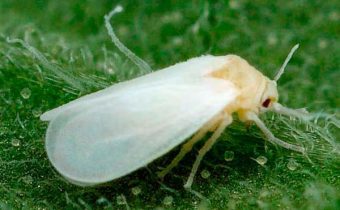What kind of black midges on tomatoes? And how to get rid of them?
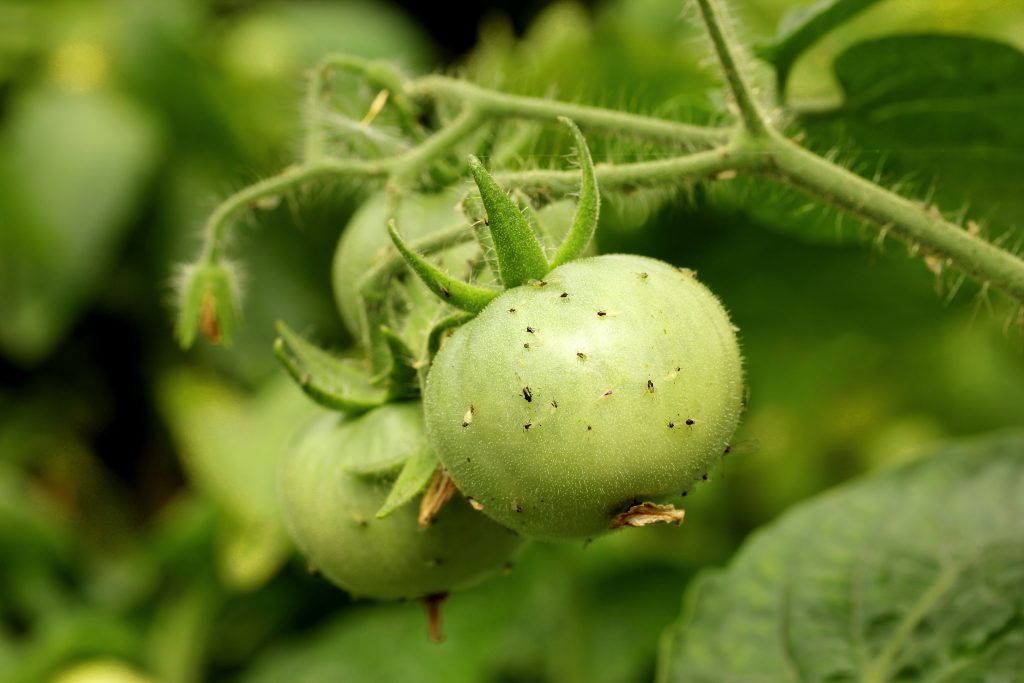
Sometimes not only bees and bumblebees twine around flowering bushes of tomatoes, but also small black midges that are not related to pollinating insects. The appearance of blackflies should alert the gardener - most likely, the plants were attacked by a winged aphid or cycard, a dangerous pest of tomatoes.
Pest characteristic
The winged aphid is an insect 1-2 mm in length, possessing a black body and transparent wings. Adults, like the larvae, feed on the sap of cultivated and weedy plants, hiding on the underside of the leaves. Insect breeds intensively, up to 5 generations of midges can be bred for a season. Thanks to its wings, the pests easily move from the bush to the bush, spreading over the planting.
The danger of winged aphids for tomatoes
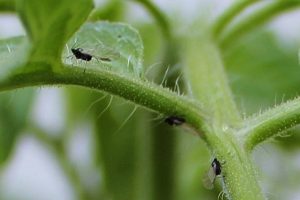
The rapidly growing population of blackflies can cause serious damage to tomato beds, depleting individual bushes until the plants die. In addition, pests are carriers of viruses and leave pad on plants - a favorable breeding ground for fungi. With a significant defeat cyclists loss of yield of tomatoes can be about 30%.
Symptoms of winged tomato aphids:
- wilting and twisting of the lower leaves;
- black sticky marks on the plant;
- dark spots on the stems;
- the appearance of dry brown peel on the spot.
How to distinguish from a tomato mosquito
Black midges may be representatives of another species - a mushroom or tomato mosquito. The insect appears more often on the seedlings, whereas the peak of reproduction of the winged aphid occurs during the flowering period of the tomato, but if the soil is too wet, the pest can appear in the greenhouse at any stage of plant development.
The mushroom mosquito looks like a larger black midge than a cicadon, reaching 3-4 mm in length. Adults also drink the juice of the plants, preferring the delicate tissue of the apical shoots, so they can damage the growing point of tomatoes. But the greatest harm to the tomatoes is caused by the insect larva. The midges lay transparent-white eggs into the ground, from which white worms appear from 3 to 8 mm in length with a black head. In this phase, insects constantly inhabit the soil, feeding on plant roots, then pupating.
Tomato mosquito is less dangerous for tomatoes than winged aphid, the greatest threat to young plants with undeveloped root system. The status of adult tomatoes slight damage to the roots is unlikely to be significantly affected. But we should not ignore the pests - a large accumulation of larvae in the soil can lead to slower growth of the bushes, the absence or weak formation of ovaries. In addition, tomato mosquito - a carrier of bacteria.
The presence of a large number of ants near the planting of tomatoes speaks in favor of defeating aphids.
Fighting winged aphids
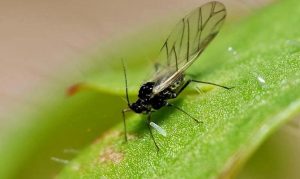
Regardless of what kind of insect attacked tomatoes, aphid or mosquito, both pests can pose a threat to the crop, so you need to remove them from the site. Expelling winged aphids will be more difficult.Large-scale damage can force the gardener to use chemicals, however, during the flowering period, when pest invasion is usually observed, the use of toxic chemicals has limitations.
Specialized drugs
The most effective chemical aids against aphids are systemic insecticides. The preparations guarantee long-term protection, but are highly toxic and are long removed from plant tissues. A more suitable option would be an enteric-contact medication, such as Aktara or Decis Profi. The active substances of these funds are removed much faster.
The safest option, which is best used for processing tomatoes in greenhouses, is biological pesticides - Fitoverm, Aversectin, Actofit. To fight the midge, it will take about 3 sprays with a break of 5-7 days.
Folk remedies
It is worth starting the treatment of bushes with the use of folk remedies, not least because of their safety for pollinating insects (even biopesticides pose a threat to beneficial insects). But it will be possible to withdraw with their help only a small population of pests, while processing should be carried out several times.
The strongest home remedies for aphids:
- Soap and wood ash. 20 g of soap chips should be dissolved in a bucket of warm water and mixed with 250 g of wood ash.
- Vinegar. A tablespoon of vinegar is dissolved in a liter of water and sprayed planting tomatoes. The dosage is indicated for 9% vinegar, respectively, 3% for the same volume of water will require 3 spoons.
- Garlic, pepper, mustard. Chopped teeth of 2 heads of garlic, 2 tablespoons of red bitter pepper and 6 tablespoons of mustard powder should be poured with a bucket of hot water and leave for 2-3 days. It is better to carry out the treatment not by spraying, but wetting the leaves, paying particular attention to the lower tier of the bush.
- Celandine. 4 kg of crushed green parts of the plant is poured with a bucket of water and insist day. The resulting infusion is brought to a boil and roasted for 30 minutes. After straining, 1 part of the infusion is diluted with 10 parts of water and left to stand in a dark place for another 48 hours. After this tool is ready for spraying. Re-use of the infusion is allowed after 5 days.
Removal of tomato mosquito

Measures against the pest should be aimed at destroying the larvae and scaring away adult plants in order to prevent eggs from laying in the ground near the roots of the plants.
If the midges appeared on the seedlings, a clove of garlic or a pinch of shredded tobacco should be buried in each container.
To remove adult individuals of tomato mosquitoes, the use of pesticides does not justify itself - it is enough to allow the top layer of soil to dry and set traps for the mechanical destruction of the midge. As traps, they use yellow cartons smeared with honey, vegetable oil, petroleum jelly or other viscous and sticky substance, periodically replacing them.
Spraying folk remedies
You can scare away the midge from planting by treating the bushes with broths and infusions with a strong aroma. Suitable infusions of vinegar, pepper and mustard, which are used for breeding winged aphids. In addition, the mushroom mosquito does not like:
- Dandelion. Crushed leaves, stalks and dandelion roots are poured with water at the rate of 1 kg per bucket. Insist about a day. The tool acts against adults and against the larvae, if you water them with the trunk of a bush.
- Garlic. 2 crushed garlic heads pour a liter of water and insist 5 days. Before use, dilute with 5 liters of water.
- Bow. 650 g of onion peel need to pour 10 liters of boiling water. After cooling, the infusion can be used to spray the bushes.
- Tomato plant. Grind the leaves of tomatoes and pour hot water (20 tablespoons of raw materials for 5 liters of water). Insist should be 12 hours.
Soil treatment

The larvae of a tomato mosquito die in dry ground, so for their destruction it is enough to stop watering for a while. But during the flowering period of tomatoes, it is necessary to resort to this measure with caution - a shortage of water can cause ovaries to fall off. An alternative and safer option is dusting the beds with wood ash.
For the destruction of a large population of black midge larvae use insecticides against soil pests:
- "Basudin" - about 1.5 months;
- "Thunder-2" - protects against larvae within 2 months.
Means are mixed with sand, distributed in the near-stem circle of a tomato bush and sprinkled with a two-centimeter layer of soil. Two or three days after this treatment, tomatoes should not be watered.
At sufficiently low temperatures in winter, the tomato mosquito larvae that have gone into the soil, die, so if possible, it is advisable to disassemble the greenhouse to freeze the soil.
At the time of the fight against midges, it is worth refusing from manure and bird droppings fertilizers, since adult individuals prefer to lay eggs in the soil saturated with organic matter.
Prevention
Common measures against both pests that also prevent the occurrence of many other pests and fungal diseases on tomatoes will be:
- Regular removal and burning of weeds during the growing season, as well as autumn cleaning of the site. Weeds are breeding grounds and are a great place for wintering insects and fungi.
- Deep soil digging in the fall.
- If black midges bred in the greenhouse, after harvesting should be fumigated with sulfur, burning 200 g of the substance 1 m3. After the procedure, it is advisable to keep the greenhouse closed for at least 4-5 days, then ventilate. This tool acts on aphids and tomato mosquito on all phases of development.
- Measures to prevent winged aphid attacks are effective against other species of this pest. Prevention in this case is the most justified, since aphid can cause serious damage to tomatoes, potatoes, cabbage, cereals, melons and gourds.
- Ants breeding. Insects feed on aphids, and therefore contribute to its distribution in plantings. Cases have been recorded when the winged aphid hid for the night in an anthill. Therefore, first of all, it is necessary to detect all the anthills on the site and destroy them chemically.
- Attraction of beneficial insects. Winged aphids feed on wasps, ladybugs and gold-eyed. Sowing dill next to the planting of tomatoes, you can lure these insects.
- Attracting natural enemies pest. Aphids feed on warblers, tits, and linnet.
- Sowing scare herbs. Pests avoid fragrant plants, you can scare away aphids, sowing garlic, basil, peppermint, marigold, cilantro, fennel between rows.
To avoid the appearance of a tomato mosquito is simple - it is enough to observe the regime of watering, avoiding an excess of moisture in the soil.
Both insects love a warm and humid microclimate, so greenhouse tomatoes often hit. White midges (whitefly) may appear in the shelter, greenhouse conditions are favorable for many pests and fungi. Therefore, special attention should be paid to the prevention and examination of crops growing in closed ground.


